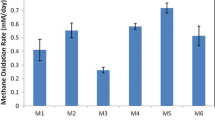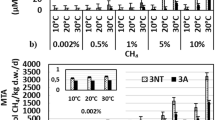Abstract
Active methanogenesis from organic matter contained in soil samples from tundra wetland occurred even at 6 °C. Methane was the only end product in balanced microbial community with H2/CO2 as a substrate, besides acetate was produced as an intermediate at temperatures below 10°C. The activity of different microbial groups of methanogenic community in the temperature range of 6–28 °C was investigated using 5% of tundra soil as inoculum. Anaerobic microflora of tundra wetland fermented different organic compounds with formation of hydrogen, volatile fatty acids (VFA) and alcohols. Methane was produced at the second step. Homoacetogenic and methanogenic bacteria competed for such substrates as hydrogen, formate, carbon monoxide and methanol. Acetogens out competed methanogens in an excess of substrate and low density of microbial population. Kinetic analysis of the results confirmed the prevalence of hydrogen acetogenesis on methanogenesis. Pure culture of acetogenic bacteria was isolated at 6 °C. Dilution of tundra soil and supply with the excess of substrate disbalanced the methanoigenic microbial community. It resulted in accumulation of acetate and other VFA. In balanced microbial community obviously autotrophic methanogens keep hydrogen concentration below a threshold for syntrophic degradation of VFA. Accumulation of acetate- and H2/CO2-utilising methanogens should be very important in methanogenic microbial community operating at low temperatures.
Similar content being viewed by others
References
Aselmann I & Crutzen PJ (1989) Global distribution of natural freshwater wetlands and rice paddies, their net primary productivity, seasonality and possible methane emissions. J. Atmos. Chem. 8: 307–358
Bak F (1988) Sulfatreduzierende Bakterien und ihre Aktivität im Litoralsediment der Unteren Gull (Überlinger See). Hartung-Gorre Verlag Konstanz: 154–158
Chuvilskaya NA, Obraztsova AYa, Belokopytov BF, Laurinavichus KS, Atakishiyeva YaYu & Akimenko VK (1989) An immunological assay of thermophilic anaerobic bacteria Mikrobiologiya 58: 489–493
Conrad R, Bak F, Seitz HJ, Thebrath B, Mayer HP & Schütz H (1989) Hydrogen turnover by psychrotrophic homoacetogenic and mesophilic methanogenic bacteria in anoxic paddy soil and lake sediment. FEMS Microbiol. Ecol 62: 285–294
Conrad R, Schutz H. & Babbel M. (1987) Temperature limitation of hydrogen turnover and methanogenesis in anoxic paddy soil. FEMS Microbiol. Ecol. 45: 281–289.
Drake HL (1992) Acetogenesis and acetogenic bacteria. In: Lederberg J (Ed.) Encyclopedia of Microbiology. Vol 1 (pp 1–15) Academic Press, San Diego, CA.
Gujer W & Zehnder AJB (1983) Conversion processes in anaerobic digestion. Water Sci. Technol. 15: 627–667
Harriss RC, Gorham E, Sebacher DI, Bartlett KB & Flebbe PA (1985) Methane flux from northern peatlands. Nature 315: 652–654
Jones JG & Simon BM (1985) Interaction of acetogens and methanogens in anaerobic freshwater sediments. Appl. Environ. Microbiol. 49: 944–948.
Khalil MAK & Rasmussen RA (1983) Sources, sinks, and seasonal cycles of atmospheric methane. J. Geophys. Res. 88: 5131–5144.
Kotsyurbenko OR, Nozhevnikova AN, Kalyuzhnyi SV & Zavarzin GA (1993a) Methanogenic digestion of cattle manure at low temperature. Mikribiologiya 62: 761–771.
Kotsyurbenko OR, Nozhevnikova AN & Zavarzin GA (1993b) Methanogenic degradation of organic matter by anaerobic bacteria at low temperature. Chemosphere 27: 1745–1761
Kotsyurbenko OR, Simankova MV, Nozhevnikova AN, Zhilina TN, Bolotina NP, Lysenko AM & Osipov GA (1995) New species of psychrophilic acetogens: Acetobacterium bakii sp.nov., A.paludosum sp.nov., A.fimetarium sp.nov. Arch. Microbiol. 163: 29–34.
Matthews E & Fung I. (1987) Methane emission from natural wetlands: Global distribution, area, and environmental characteristics of sources. Global Biogeochem. Cycles 1: 61–86.
Nozhevnikova AN, Kotsyurbenko OR & Simankova MVO (1994) Acetogenesis at low temperature. In: Drake HL (Ed.) Acetogenesis and acetogenic bacteria. (pp 416–431) Chapmann & Hall, New York-London.
Nozhevnikova AN & Kotsyurbenko OR (1995) Microbiological fundamentals of methanogenesis in a wide range of temperatures (5–75°C) In: Marhaim U & Ney G (Eds.) Biogas technology as an environmental solution to pollution (pp 1–25) Forth FAO/SREN Workshop, Migal, Israel June 1994. REUR Technological series 33, FAO of UN, Rome.
Nozhevnikova AN & Lebedev VS (1995) Burrial sites of municipal garbage as a source of atmospheric methane. Int. Quatr. J. of ‘Ecological Chemistry’ 4, N1: 48–58.
Nozhevnikova AN, Nekrasova VK, Lebedev VS & Lifshitz AB (1993) Microbiological processes in landfills. Wat. Sci. Technol. 27, No 2: 243–252
Nozhevnikova AN & Yagodina TG (1982) Thermophilic acetate-utilizing methanogenic bacterium (TAMB) Mikrobiologiya 51: 642–649.
Omelchenko MV, Savelieva ND, Vasilyeva LV (1992) Zavarzin GA. Psychrophilic methanotrophic community from tundra soil. Mikrobiologiya 61: 1072–1077
Omelchenko MV, Vasilyeva LV & Zavarzin GA (1993) Psychrophilic methanotroph from tundra soil. Current Microbiol 27: 255–259
Parshina SN, Nozhevnikova AN & Kalyuzhnyi SV (1993) Degradation of protein substrates by microflora of pig's manure at low temperature. Mikrobiologiya 62: 169–180.
Phelps J & Zeikus JG (1984) Influence of pH on terminal carbon metabolism in anoxic sediments from a mildly acidic lake. Appl. Environ. Microbiol. 48: 1088–1095.
Pfennig N & Lippert KD. (1966) Über das Vitamin B12 Bedürfnis phototropher Schwefelbakterien. Arch. Microbiol. 55: 245–256
Rotmans J, Elzenden MGJ, Krol MS, Swart RJ & Woervan der HJ (1992) Stabilizing atmospheric concentrations: towards international methane control. Ambio 21, N6: 404–413
Schink B (1991) Syntrophism among Prokaryotes. In: Balows A, Trüper H, Dworkin M, Harder W & Schleifer K-H (Eds). The Prokaryotes Vol. 1 (pp 276–299). Springer-Verlag.
Slobodkin AI, Panikov NS & Zavarzin GA. (1992) Microbiological methane production and consumption in the tundra and middle taiga bogs. Mikrobiologiya 61: 683–691
Sutter K, Egger K & Wellinger A. (1987) Psychrophilic methane production: A low rate, but economically viable technique. In: Vesiroglu TN (Ed.) Alternative energy sources VII, Vol. 4, (pp. 87–98) Hemisphere, Washington
Svensson BH. (1984) Different temperature optima for methane formation when enrichments from acid peat are supplemented with acetate or hydrogen. Appl. Env. Microbiol. 48: 389–394
Svensson BH. & Rosswall T (1984) In situ methane production from acid peat in plant communities with different moisture regimes in a subarctic mire. Oikos 43: 341–350
Tans PP, Fung IY & Takahashi T. (1990) Observational constraints on the global atmospheric carbon dioxide budget. Science 247: 1431–1438
Wolin EA, Wolin MJ & Wolfe RS (1963) Formation of methane by bacterial extracts. J. Biol. Chem. 238: 2882–2886
Zavarzin GA (1986) Trophic relations in methanogenic community. Izvestiya AN USSR Ser. biol. N3: 341–360 (in Russian)
Zavarzin GA, Kotsyurbenko OR, Soloviova TI & Nozhevnikova A.N. (1993) Temperature threshold during development of methanogenic or acetogenic microbial community from tundra soil. Dokl. Academii Nauk, 329: 792–794 (in Russian).
Zavarzin G.A., Nozhevnikova A.N. 1993. Landfills and waste deposits producing greenhouse gases. Current Op. in Biotechnol. 4 (3): 356–362.
Zeemann G, Sutter K, Vens T, Koster M & Wellinger A. (1988) Psychrophilic digestion of dairy cattle and pig manure: start-up procedures of batch and CSTR-type digesters. Biological wastes, 26: 15–31.
Zhilina TN & Zavarzin GA (1991) Methane production at low temperature by the pure culture of Methanosarcina. Doklady AN USSR 317: 1242–1245 (in Russian).
Author information
Authors and Affiliations
Rights and permissions
About this article
Cite this article
Kotsyurbenko, O.R., Nozhevnikova, A.N., Soloviova, T.I. et al. Methanogenesis at low temperatures by microflora of tundra wetland soil. Antonie van Leeuwenhoek 69, 75–86 (1996). https://doi.org/10.1007/BF00641614
Issue Date:
DOI: https://doi.org/10.1007/BF00641614




